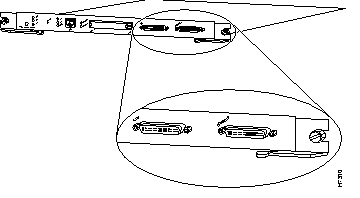|
|

This chapter describes the LightStream 1010 Asynchronous Transfer Mode (ATM) switch processor (ASP), shown in Figure 1-1. The ASP is the main system processor in the ATM switch that contains the ATM switching engine and network management processor for the system software and most of the system memory components. It maintains and executes the management functions that control the system.

The LightStream 1010 ATM switch is the Cisco Systems next-generation ATM switch for workgroup and campus backbone deployment. Incorporating support from the latest ATM Forum specifications and building upon the Cisco System's Internetwork Operating System (IOS) software, the LightStream 1010 offers the most complete, sophisticated feature set of any ATM switch in its class. It also provides the performance, scalability, and robustness required for production ATM deployment.
The LightStream 1010 uses a five-slot, modular chassis featuring the option of dual, fault-tolerant, load-sharing AC or DC power supplies. The central slot in the LightStream 1010 is dedicated to a single, field-replaceable ASP module that supports 5-Gbps shared memory and a fully nonblocking switch fabric. The ASP also supports the feature card and high-performance reduced instruction set (RISC) processor that provides the central intelligence for the device. The remaining slots support up to four hot-swappable carrier modules (CMs). Each CM supports up to two hot-swappable port adapter modules (PAMs) for a maximum of eight PAMs per switch, maintaining a wide variety of desktop, backbone, and wide-area interfaces.
See the following documents for detailed chassis hardware and PAM installation and configuration information:
The LightStream 1010 ATM switch should be installed in a standard 19-inch (48-centimeter) rack.
For detailed information about the switch features, an overview of ATM, applications, and functions, see the chapter "What is the LightStream 1010 ATM Switch?" in the LightStream 1010 ATM Switch Hardware Installation Guide.
The ASP has the following features:
In addition to these features, the ASP performs the following management functions:
The ASP must be installed in slot 2, the middle slot when facing the front panel. (See Figure 3-2.)
The embedded Flash memory allows you to remotely load and store system software images. You can download a new software image over the network or from a local server, and add the new image to Flash memory or replace an existing file.
The LEDs on the ASP indicate the status of the system, which includes the fan assembly and power supplies and the ASP. The ASP LEDs are shown in Figure 1-2 and described in Table 5-1.

For detailed ASP LED descriptions, see the section "Module LEDs" in the chapter "Checking the ASP Installation."
The RESET switch is located behind the faceplate of the ASP, through a small hole approximately 1.5 inches to the right of the ASP status LED. (See Figure 1-2.)
The Ethernet RJ-45 port (labeled Enet) can be used to connect a management workstation and enables SNMP management of the LightStream 1010 ATM switch. (See Figure 1-2.)
The dual-height PCMCIA, Type II card slot, shown in Figure 1-3, can be used to store Cisco IOS software or system configuration information on a Flash card. The switch can also boot from the software stored on the Flash card.

For detailed PCMCIA Flash card descriptions, see the section "Using PCMCIA Flash Memory" in the chapter "Maintaining the LightStream 1010 ATM Switch Processor."
The ASP CONSOLE port supports a data communications equipment (DCE) EIA/TIA-232 interface type and mode. For descriptions and illustrations of each connector type, refer to the section "EIA/TIA-232 Connections" in the chapter "Preparing for Installation." For cable pinouts, refer to the appendix "ASP Cabling Specifications."
When connecting a serial device, consider the cable as an extension of the switch for an external connection; therefore, use null-modem cable to connect the switch to a remote DCE device such as a modem or data service unit (DSU), and use a straight-through cable to connect the switch to a data terminal equipment (DTE) device such as a terminal or PC. (See Figure 1-4.)

The feature card is a daughter card of the ASP module, and implements a number of value-added capabilities over and above the base switch mechanisms. These include the following:
Supporting such capabilities on the field-replaceable feature card allows you to upgrade the LightStream 1010 ATM switch in the field as and when such standards evolve and more advanced mechanisms are required.
|
|